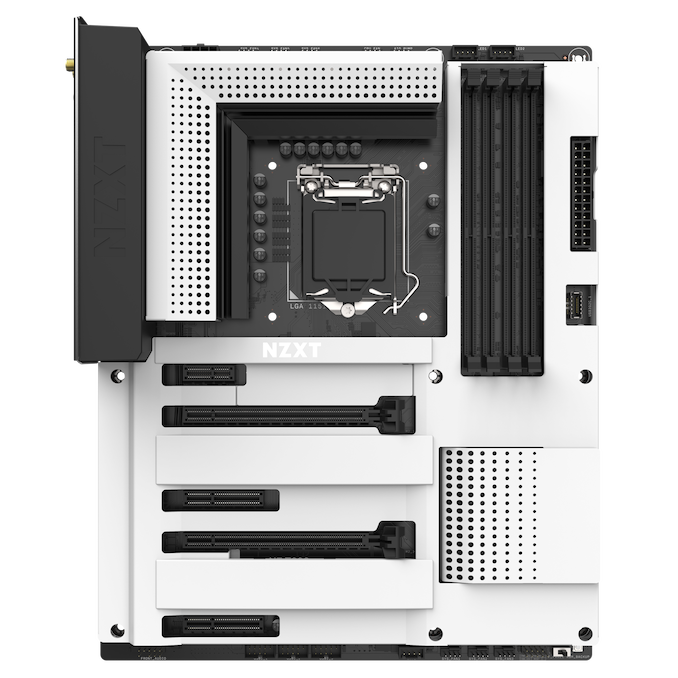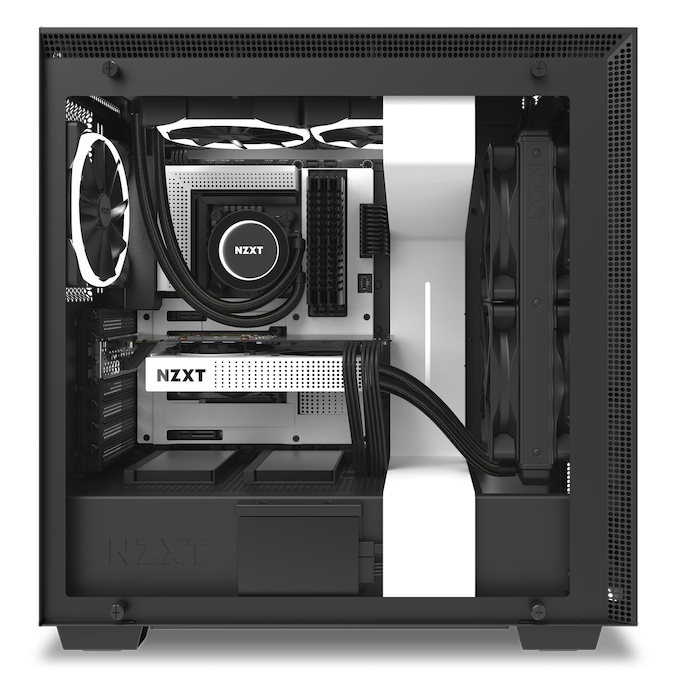Intel Z390 Motherboard Overview: 50+ Motherboards Analyzed
by Ian Cutress & Gavin Bonshor on October 8, 2018 10:53 AM EST- Posted in
- Motherboards
- Intel
- MSI
- Gigabyte
- ASRock
- EVGA
- Asus
- NZXT
- Supermicro
- Z390
NZXT N7 Z390
Right at the start of this year, NZXT launched their first 'component' onto the market and while NZXT themselves don't manufacturer computer hardware per say, the N7 Z370 which we reviewed at its launch. The N7 Z370 was manufactured by ECS o NZXT themselves created the majority its feature set with very unique aesthetics. The main selling point for NZXT on the N7 was through this unique design which included a full PCB cover with users having a choice between two primary color schemes; black cover and black PCB, or white cover and black PCB. NZXT essentially took the style from some of their renowned PC cases and integrated to the motherboard market giving users the ability to create something unique This full cover feature was enhanced with the inclusion of removable plates on the full cover which could be modified with spray paint, or with the option to purchase additional plates in different colors for an additional cost. Even the full cover could be removed, spray painted and re-designed to give the ultimate look, which is a rather refreshing idea given the number of users voiding their warranties with minor modifications to create their own style inside their systems.
The new NZXT N7 Z390 keeps much of the same specifications as the previous NZXT N7 Z370 board with a cover which stretches from top to bottom across the majority of the PCB with the only bare elements being located around the CPU socket and along the very top and bottom of the board. As with the N7 Z370, the N7 Z390 will be available with white or black full-PCB covers. The N7 Z390 also keeps the same PCIe layout with a full-length PCIe 3.0 x16 slot, a full-length PCIe 3.0 x8 slot, two PCIe 3.0 x4 slots and a single PCIe 3.0 x1 slot.
A total of two PCIe 3.0 x4 and SATA compatible M.2 slots are located under the cover with a supplement of just four SATA ports; an ATX sized board on a chipset offering six ports should really have six ports. The included SATA ports feature support for RAID 0, 1, 5 and 10 arrays. In regards to the cooling, the NZXT N7 Z390 is one of the more comprehensive offerings with a total of eight 4-pin fan headers with two designated as for a CPU fan and AIO pump, and the other six featuring support for 0 db mode with support for up to 6 W of power per channel.
On the rear IO is a good variation of connections including four USB 3.1 Gen2 Type-A ports, two USB 3.0 Type-A ports, a single LAN port controlled by an Intel I219V Gigabit NIC, with a total of five 3.5 mm audio jacks and S/PDIF optical output powered by a Realtek ALC1220 HD audio codec. A single HDMI 1.4b video output is present with a set of very handily placed buttons which consist of a clear CMOS, reset and power switch. The rear IO now includes an LED debug which is handy, but the location might not be when troubleshooting in a cramped location. Lastly there's two antenna connectors for the integrated 2T2R Wave 2 802.11ac capable Intel 9560 Wi-Fi adapter which offers users with compatible wireless networking capabilities to utilize up to 1.73 Gbps speeds.
The NZXT N7 Z390 has an MSRP of $280 which like it's predesessor (the N7 Z370) is directly placed into the higher end of Z390 offerings, with NZXT looking to compete with other premium offerings available on the chipset. The NZXT N7 Z390 is compatible with a wide variety of NZXT's other products with capability expanded on by the CAM software with HUE 2 and GRID+ support which offers control over RGB lighting and onboard fans respectively. Availability of the N7 Z390 is expected from the middle of November in the US market and in the EU towards the end of November.












79 Comments
View All Comments
pawinda8 - Monday, October 15, 2018 - link
Still no mention of any Z390 boards with native Thunderbolt 3 (not AIC)! Has Intel given up on Thunderbolt for the PC world?gavbon - Monday, October 15, 2018 - link
If it's not integrated into the chipset, it's not really native as such. The ASRock Z390 Phantom Gaming-ITX/ac has a Thunderbolt 3 port on the rear panel, but that's the only one I'm afraidHikariWS - Monday, October 15, 2018 - link
Oculus Rift requires 3 USB3 ports and doesn't accept any of them being connected to a hub, they all need to be connected directly into a raw port. I had to buy a dedicated 3GIO USB 3 board that added 6 useful extra ports. In my (yes, old) Gigabyte z87 mobo I also had issues using keyboard and mouse on USB 3 ports inside UEFI and some recovery softwares, so I had to buy a USB 2 mirror to connect them.Because of that, having USB 2 ports on front panel and nice quantity of USB 3 is what most differs mobos for me, given that all other features are nearly the same.
ASUS Z390-A seems to be the best option. It has the important double USB2 ports, 5 USB3 ports and still has HDMI and DP for emergencies.
just4U - Monday, October 15, 2018 - link
I wish MSI had released a "godlike" board for the Ryzen series.ThugEsquire - Tuesday, October 16, 2018 - link
You list the ASRock Z390 Phantom Gaming-ITX/ac above as an ATX board, but it's actually mITX. FYIgavbon - Friday, October 19, 2018 - link
I have gone through every page where the Phantom Gaming-ITX/ac is listed, but I can't see where it says it's an ATX board? Could you please be more specific? Are you viewing on mobile or desktop?Galcobar - Tuesday, October 16, 2018 - link
It would be really helpful to break out one more criteria into a table: Type-C header for case-front ports.Helping a friend put together an i5 system and, knowing he'll keep it for a long time, am trying to get even with peripheral connectors (already has a monitor, so no using that as a hub). It's relatively easy to identify cases with a Type-C port, but that's pointless without a motherboard header. Having to go into each board's page to check is time-consuming.
jjnam - Thursday, April 18, 2019 - link
6 months later and I'm here for EXACTLY this reason. I've gone through probably 50 manuals over the past few days squinting to find this information. What a pain.Synomenon - Thursday, October 18, 2018 - link
So on the ASRock Z390 Phantom Gaming-ITX/ac, is the TB3 port on the rear using up lanes from CPU (making the only 16x slot, 8x only)?If it's not using lanes from the CPU, how will using that TB3 port (say with a USB3.1 Gen2 hub OR TB3 hub) affect all the other ports / IO on the board?
repoman27 - Thursday, October 18, 2018 - link
Going off of what TweakTown published, it's a single-port Intel JHL6240 "Alpine Ridge" controller with a PCI 3.0 x2 connection to the PCH. So it won't affect the PEG lanes from the CPU. I'm amazed it's not Titan Ridge at this point though.